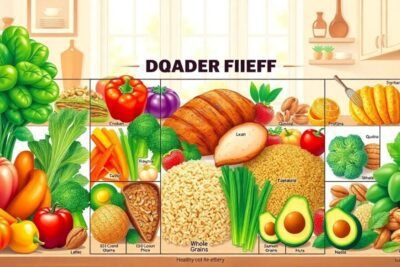
How to reverse diabetes diet plan
Reversing diabetes through diet is a powerful approach that can significantly improve health outcomes. By focusing on the right foods and habits, individuals can take charge of their diabetes management. This article will explore various aspects of a diabetes-friendly diet plan.
Understanding how to effectively manage diabetes through dietary choices is essential for those looking to improve their overall health and well-being. A well-structured meal plan can be the key to controlling blood sugar levels and promoting long-term health.
- How can a healthy diet and lifestyle prevent diabetes?
- What are the key components of a diabetes meal plan?
- How can you effectively manage blood glucose levels?
- What foods should be included in a diabetic diet?
- How to create a personalized diabetes meal plan?
- What are the benefits of regular meal times for diabetics?
- How can healthy snacking help manage diabetes?
- Frequently asked questions about managing diabetes through diet
- Related questions on diabetes diet management
How can a healthy diet and lifestyle prevent diabetes?
A healthy diet plays a pivotal role in diabetes prevention. By focusing on nutrient-dense foods, individuals can significantly reduce their risk of developing type 2 diabetes. Incorporating whole grains, fruits, and vegetables into daily meals helps maintain blood sugar control and supports overall wellness.
In addition to diet, a holistic lifestyle that includes regular physical activity can further enhance the effects of a healthy eating plan. Engaging in activities such as walking, swimming, or yoga not only aids in weight management but also boosts insulin sensitivity.
Moreover, maintaining a healthy weight is crucial. Studies show that even modest weight loss can improve blood glucose levels and reduce the risk of diabetes. Therefore, adopting a balanced diet coupled with an active lifestyle is an effective strategy for diabetes prevention.
What are the key components of a diabetes meal plan?
Creating an effective diabetes meal plan involves understanding the core components that contribute to balanced nutrition. The following key elements should be included:
- Low glycemic index foods: Foods that have a lower impact on blood sugar levels are ideal.
- Balanced macronutrients: Each meal should contain a mix of carbohydrates, proteins, and healthy fats.
- Portion control: Monitoring portion sizes helps manage caloric intake and blood sugar levels.
- Regular meal times: Eating at consistent times can help stabilize blood glucose levels.
Incorporating these components into a daily regimen enables individuals to manage their diabetes effectively. It's also advisable to consult with a dietitian to tailor the meal plan according to personal preferences and health goals.
How can you effectively manage blood glucose levels?
Effective blood glucose management requires a comprehensive approach. Here are some strategies to consider:
- Monitor carbohydrate intake: Understanding the carbohydrate content in foods is essential for blood sugar control.
- Incorporate fiber-rich foods: Foods high in fiber can help slow down sugar absorption and improve digestion.
- Stay hydrated: Drinking enough water is important for overall health and can aid in blood sugar regulation.
Additionally, regular physical activity is vital. Exercise helps the body use insulin more effectively, further assisting with blood glucose management. Combining these strategies can lead to favorable outcomes for those managing diabetes.
What foods should be included in a diabetic diet?
To create a balanced diet that supports diabetes management, it is important to include a variety of food groups. Some of the best foods for reversing diabetes naturally include:
- Non-starchy vegetables like spinach, kale, and broccoli.
- Whole grains such as quinoa, brown rice, and oats.
- Lean proteins, including chicken, turkey, fish, and legumes.
- Healthy fats, like those found in avocados, nuts, and seeds.
- Fruits, especially berries, which are lower in sugar compared to other fruits.
Incorporating these foods into your diet can promote overall health and assist in blood sugar control. It's also essential to limit processed foods, added sugars, and saturated fats.
How to create a personalized diabetes meal plan?
Creating a personalized diabetes meal plan involves several important steps. First, assess your dietary preferences and lifestyle. Consider what foods you enjoy and what you are willing to incorporate into your diet.
Next, establish your caloric needs based on age, activity level, and weight goals. This ensures that your meal plan is tailored to your specific requirements.
Once you've identified your preferences and caloric needs, focus on a variety of nutrient-dense foods. Aim to include:
- Colorful vegetables to ensure a broad spectrum of vitamins and minerals.
- Lean proteins for muscle maintenance and repair.
- Whole grains for sustained energy release.
Lastly, regularly review and adjust your meal plan as needed. Consulting with a healthcare professional, like a dietitian, can provide additional insights and recommendations.
What are the benefits of regular meal times for diabetics?
Establishing regular meal times is beneficial for those managing diabetes for several reasons. Firstly, it helps maintain stable blood sugar levels. By eating at consistent times, the body can better anticipate insulin needs and regulate glucose more effectively.
Additionally, regular meal times can aid in appetite control, preventing overeating or excessive snacking. This consistency helps individuals make healthier choices by planning meals in advance.
Furthermore, adhering to a schedule can enhance overall health by promoting better digestion and nutrient absorption, leading to improved energy levels and well-being.
How can healthy snacking help manage diabetes?
Healthy snacking plays a crucial role in diabetes management. Choosing the right snacks can help stabilize blood sugar levels and prevent energy crashes. It is essential to select snacks that are low in sugar and high in fiber and protein.
Some examples of healthy snacks for diabetes management include:
- Raw vegetables with hummus or guacamole.
- Greek yogurt topped with nuts or seeds.
- Whole grain crackers with cheese.
These options not only provide essential nutrients but also keep hunger at bay between meals, which can help with portion control during main meals.
Frequently asked questions about managing diabetes through diet
Which diet is best for reversing diabetes?
The best diet for reversing diabetes typically includes a focus on whole, unprocessed foods. Emphasizing low-glycemic foods, high fiber intake, and healthy fats can create a favorable environment for blood sugar control. Additionally, monitoring portion sizes and meal timing contributes to effective diabetes management.
What is the quickest way to reverse diabetes?
While there is no one-size-fits-all answer, adopting a comprehensive approach that includes a balanced diet, regular exercise, and lifestyle modifications can yield rapid results. Prioritizing weight loss and reducing sugar intake can significantly impact blood glucose levels.
What can I eat to stop diabetes?
Focusing on nutrient-dense foods is key. Incorporate plenty of non-starchy vegetables, whole grains, lean proteins, and healthy fats into your meals. Avoid processed foods and added sugars to better manage blood sugar levels.
What should diabetics drink first thing in the morning?
For optimal blood sugar management, diabetics may benefit from starting their day with water or herbal teas. These beverages hydrate the body without adding sugars. Some may also choose low-sugar smoothies that include beneficial ingredients like spinach, avocado, or unsweetened almond milk.










